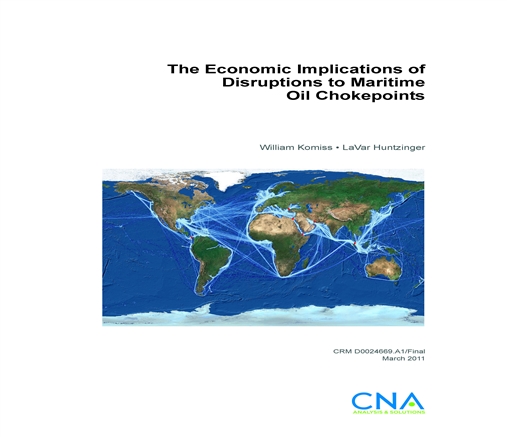The free flow of oil is critical to world commerce and global eco- nomic prosperity. Oil trade requires the use of maritime trade routes, which can span from hundreds to thousands of miles. Hence, oil tankers often travel through straits and canals to reduce transport costs. These passageways—referred to as chokepoints—are narrow channels along the most widely used global sea routes.
This study evaluates how potential disruptions at critical chokepoints could affect the U.S. economy and economies around the world. While our methods could be used to understand the importance of any chokepoint, we focus on the Strait of Hormuz, the Strait of Mal- acca, the Suez Canal, the Bab el-Mandeb Strait, the Turkish Straits, and the Panama Canal. At any of these chokepoints, the world’s oil supply is at risk of disruption, and the oil transported through these chokepoints has great value. As much as 17 million barrels per day (bbd) flow through the Strait of Hormuz alone. Additionally, choke- points tend to be in proximity to poor countries, which often lack institutions that can enable or provide maritime security.
Threats to the world’s chokepoints are numerous and diverse. The Strait of Hormuz is under a direct threat of closure by Iran. Somali pirates and terrorists are a growing concern for traffic through the Bab el-Mandeb Strait and the Suez Canal. China may become involved in a conflict over the Strait of Malacca as Asia’s demand for energy grows, and environmental catastrophes could grow in scale and frequency in the Turkish Straits as tanker traffic increases.
We must be prepared for a disruption to the flow of oil—potentially through a maritime chokepoint. The value of the oil that is at risk is high, and a large disruption is not implausible. One independent 2004 study estimated a 25-percent probability that one substantial dis- ruption would occur before 2014 [1]. (A substantial disruption is one involving 5 million bbd or more—equal to or greater than that expe- rienced after the 1990 Invasion of Kuwait).
If a disruption occurs, countries could mitigate the gross loss to the flow of oil in several ways. Oil could be transported through major pipelines, which have more than 5 million bbd in unused capacity. In some cases, like the Strait of Malacca, oil tankers could travel along alternative trade routes. Certain oil importing countries would have the option to draw down their strategic reserves, and certain oil exporting countries could provide more oil than they otherwise would supply to the market.
We account for potential mitigation in our economic theory of oil supply disruptions. A disruption to the supply of oil transported through a chokepoint is assumed to cause a country’s supply of oil to fall by an amount equal to the product of (1) the net number of bar- rels disrupted and (2) the probability that a barrel is en route to that country given it is transported through that chokepoint. The coun- try’s reduced supply of oil would cause the level of total production to decline. Therefore, the country’s national, or total, income would fall and its unemployment rate would rise. The oil supply disruption would cause an eventual increase in the price of oil, and the rate of inflation—or growth rate of overall prices—would rise.
Our method for using this theory to estimate the economic impacts of oil supply disruptions is straightforward. We draw on two tech- niques—Input-Output analysis and Keynesian analysis. These meth- ods are often used by economists to measure the effects of macroeconomic shocks, and our calculations involve only simple algebra. We use data that are publicly available from sources like the Energy Information Agency (EIA) and the CIA World Factbook.
We find that a few of the world’s industrialized countries would enter a sudden, steep recession if a major oil disruption occurs at the Strait of Hormuz and the countries with large strategic reserves do not share them with the rest of the world. Our findings for the economic impacts of disruptions on the United States are similar to the results of comparable studies. However, where those studies focus solely on the U.S. economy, we examine the effects of oil supply disruptions on over 30 countries for which the required data are available.
Download reportApproved for Public Release; Distribution Unlimited. Specific authority: N00014-05-D-0500.
Details
- Pages: 88
- Document Number: CRM D0024669.A1/Final
- Publication Date: 5/1/2011
